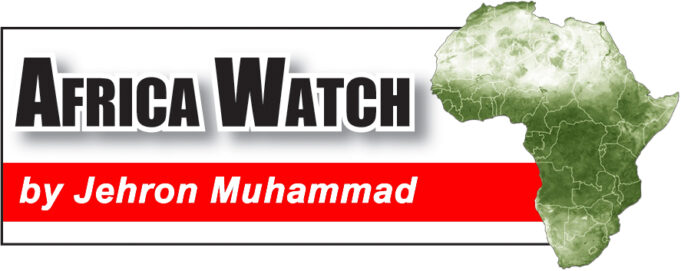In 2009 African Business magazine estimated the Democratic Republic of Congo’s (DRC) total mineral wealth at $24 trillion was the equivalent to the GDP (Gross Domestic Product) of Europe and the U.S. combined. In Susan Williams’ recent book, “White Malice: The CIA and The Covert Recolonization of Africa,” she paints a picture of a U.S. scramble for global dominance, in part, by gaining access to the natural and mineral resources of the then-Belgian Congo.
Where did the U.S. get the uranium needed to build the atom bombs it dropped on Hiroshima and Nagasaki? It was extracted from the Shinkolobwe mine in then Belgian Congo, owned by Union Miner, part of this colonial master’s biggest and wealthiest company, Society Generale de Belgique. Without access to that mine, the atom bomb may never have been built by American scientists.
The hyper-exploited Congolese miners with their paltry salaries were frequently whipped by overseers and were outfitted with little or no protection from handling the high-grade uranium—which resulted in long-term suffering, and sometimes fatal health-related consequences.
And where did the U.S. get its cobalt? According to Scientific American, “When the Nazis invaded Belgium in 1940, the company moved Society Generale headquarters to New York. “The U.S. would soon become the world’s largest user of its cobalt, which was an important metal for the manufacture of aircraft engines.”
The DRC, sometimes called the “Saudi Arabia of the electric vehicle age” produces nearly 70 percent of the world’s cobalt. It is an essential mineral used for batteries in electric cars, computers, and cell phones.
According to ecofinagency.com, demand will reach its highest yield by 2025 with 5G technology exceeding the electric vehicle.
“5G station antennas require more powerful rechargeable batteries, capable of storing enough energy to ease operations. Also, the batteries used in laptops operating with 4G will not be sufficient for the antennas receiving 5G, resulting in a need for more powerful batteries. However, all these batteries are made with lithium and cobalt oxide and there are currently no other alternatives,” the website noted.
A lengthy piece appeared in the New Yorker Magazine titled: “The Dark Side of Congo’s Cobalt Rush” by Nicholas Niarchos, who is researching for a book on the global cobalt industry. He wrote: “After independence, the southernmost province, Katanga, was viewed as a prize by Cold War powers. In the sixties, Katanga unsuccessfully tried to secede, with the support of Belgium and the Union Minière. Then, in 1978, Soviet-armed and Cuban-trained rebels seized Kolwezi and several hundred civilians were killed.
Before the insurrection, the Soviet Union appeared to have been stockpiling cobalt, and, according to a report by the C.I.A., the attack set off ‘a round of panic buying and hoarding in the developed West.’ Cobalt, the report declared, ‘is one of the most critical industrial metals.’ Then, as now, the mineral was used in the manufacture of corrosion-resistant alloys for aircraft engines and gas turbines.”
He continued: “Cobalt, the report declared, ‘is one of the most critical industrial metals.’ Then, as now, the mineral was used in the manufacture of corrosion-resistant alloys for aircraft engines and gas turbines.”
What Niarchos leaves out, that is included in Williams’ book on CIA operations in Africa, is the U.S. and its clandestine involvement in assisting Katanga in its plot to secede from the newly-liberated Congo.
On June 30, 1960, the Congo gained independence with Patrice Lumumba as its newly-elected prime minister. The U.S. and Britain and their corporate partners at the same moment conspired in assisting Katanga to secede. With Katanga being the source of much of Congo’s mineral reserves the secession was the U.S. and its partners way of maintaining ownership of much of the Congo’s mineral wealth.
In 2020 many in DRC took to social media using the hashtag #NoCongoNoPhone to fight against the cobalt supply chain that fosters child labor and the exploitation of small-scale artisanal miners.
In 2021 of the 255,000 Congolese mining for cobalt, 40,000 were children, some as young as six years old. Much of the work is informal small-scale mining in which laborers earn less than $2 per day while using their own tools, primarily their hands.
Two years ago, “a landmark was launched against the world’s largest tech companies by Congolese families who say their children were killed or maimed while mining for cobalt used to power smartphones, laptops and electric cars,” reported The Guardian.
“Apple, Google, Dell, Microsoft and Tesla have been named as defendants in a lawsuit filed in Washington, D.C., by human rights firm International Rights Advocates on behalf of 14 parents and children from the Democratic Republic of the Congo (DRC).”
The DRC has some of the world’s most valuable minerals, such as copper, gold, coltan, cobalt, and diamonds, and has the earth’s second-largest forest after the Amazon. Yet, “it is one of the world’s poorest countries as poverty and humanitarian crises plague its citizens,” wrote Michele Fabiola Lawson of the Wilson Center.
Unfortunately, a lot of African countries export raw materials, but they don’t add value to those raw materials. Also, many outside interests, including China, control DRC’s cobalt industry. It raises a very important question: Why can’t mineral rich countries like DRC control their own natural and mineral resources and, however long it takes, build infrastructure that allows it to ship abroad value-added materials? Follow @JehronMuhammad on Twitter













